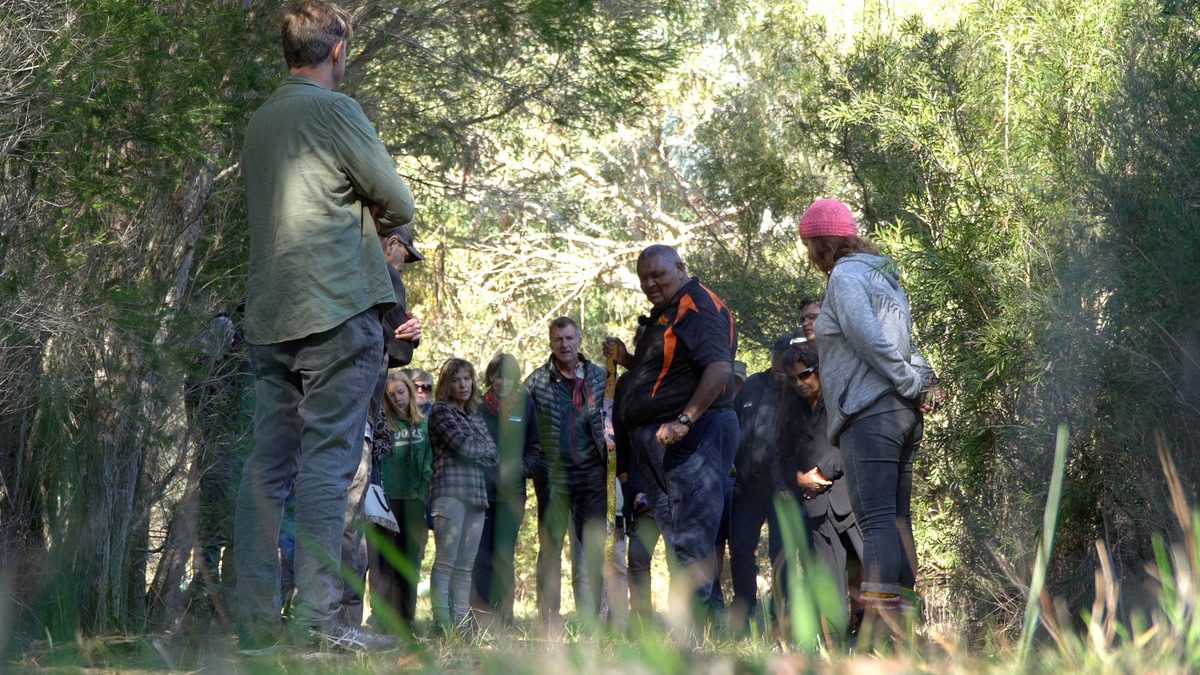Connecting with First Nations to care for Country
Landscapes Hills and Fleurieu is seeing a groundswell of landholders who are interested in connecting with First Nations to better understand cultural heritage, provide Aboriginal people access to Country via their properties, and work together in caring for land, water and nature across the region.
Landscapes Hills and Fleurieu (LHF) is seeing a groundswell of landholders who are interested in connecting with First Nations to better understand cultural heritage, provide Aboriginal people access to Country via their properties, and work together in caring for land, water and nature across the region.
A recent survey by the LHF of bushfire-affected landholders, found 20% of respondents were interested in connecting with First Nations about managing Country, and a similar percentage were also interested in exploring cultural burning on their property.
Landscapes Hills and Fleurieu's Aboriginal Partnerships Officer, Bill Wilson, said “we are hearing from more landholders who want to connect to the region’s First Nations heritage and have seen partnerships between landholders and First Nations work really well. The learnings are invaluable.”
Mark Koolmatrie of Kula-Tind-Jeri and landholder John Fargher shared an example of their collaboration at a NAIDOC event recently. John has provided access to his property at Yundi Nature Conservancy enabling Warki, Ramindjeri and Ngarrindjeri people to re-engage with the highly endangered Fleurieu Swamps. Through this partnership, and with the help of a LHF Grassroots Grant, Mark has been re-learning and sharing traditional knowledge and values linked to the swamps with other landholders. This knowledge is helping improve their management decisions.
John Fargher spoke of the mutual benefits in providing access to Country through his property.
“Working with Mark and other Ngarrindjeri Elders as a learning partnership increased the knowledge and understanding of all parties. Re-learning lost knowledges, sharing them and understanding the perspectives of all interested groups results in better land management and positive relationships between First Nations people and land owners,” he said.
The Hills and Fleurieu region sits across the traditional lands of the Kaurna, Peramangk and Ngarrindjeri First Nations. Each hold a rich cultural knowledge and spiritual connection to Country, built and maintained over millenia. This knowledge and connection puts great importance on managing the land in a culturally sensitive and environmentally sustainable way.
Tools, culturally significant trees, paintings, middens, and other physical evidence of First Nations’ rich history and land management practices are all around us and can help us understand and re-learn how First Nations people lived, travelled, traded, managed resources and protected assets across the region, at different times of the year. Whether they know it or not, landholders are likely to have evidence of this cultural history on their properties.
Landscapes Hills and Fleurieu is keen to share the message with landholders that protecting and preserving these cultural assets is a shared responsibility. In practical terms, this means keeping an eye open for evidence of First Nations cultural assets, making sure they aren’t damaged and reporting them when found.
Through Bill Wilson, the board is on-hand to answer questions and connect landholders with useful information and, if needed, the relevant First Nations authority.
“Our role is very much around working with landholders across the region to answer questions in relation to Native Title and the Heritage Act, and providing connections to further information and guidance.
“We want landholders to recognise they have a important role and responsibility in looking after First Nations cultural assets and history on their property and that they are not alone in this. There are organisations that can help. First Nations representatives and relevant authorities will work with landholders if they find something. We just ask that people reach out. Early engagement is really important.
“There is a common misconception that reporting a matter of cultural significance on private land will affect people’s tenure, result in land being taken away or prevent development – this is simply not the case. There is a process determined by the Aboriginal Heritage Act, which will enable the right people to determine how the situation is dealt with in a culturally sensitive and responsible way,” he said.
Sites of significance are protected in South Australia by the Aboriginal Heritage Act 1988. The Act makes it an offence to excavate land to uncover any Aboriginal site, object or remains or to damage, disturb or interfere with Aboriginal heritage without authorisation. Native Title exists on some public lands, waters and some pastoral lands, and while public access is not affected in these areas, traditional connection to land and waters has been maintained, enabling a model of co-existence.
“If a site or matter of cultural significance is found on private property, it may mean that First Nations representatives will need to be present as excavation work is done, or it may mean some artefacts need to be removed or protected. Ultimately, it is about being aware of what might be there and providing access to Country so that Aboriginal cultural values are respected as decisions are made,” said Mr Wilson.
Outside formal heritage protection, the board has heard from First Nations groups about their interest in accessing Country, which can play a critical role in helping Traditional Owners maintain and re-learn important parts of their culture. Many Aboriginal land management principles were lost due to European colonisation. Where landholders provide access to Country, there is an opportunity for First Nations to practice and re-learn customary land management, sometimes drawing on early colonial records and studies as a guide.
To find out more, visit our Aboriginal Partnerships page or call 8391 7500.
The First Nations partnerships project is supported by the Hills and Fleurieu Landscape Board through funding from the Australian Government's National Landcare Program.




